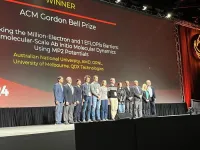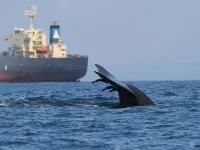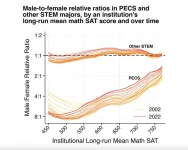(Press-News.org) ACM, the Association for Computing Machinery, named an eight-member team drawn from Australian and American institutions as the winner of the 2024 ACM Gordon Bell Prize for the project, “Breaking the Million-Electron and 1 EFLOP/s Barriers: Biomolecular-Scale Ab Initio Molecular Dynamics Using MP2 Potentials.”
The members of the team are Ryan Stocks, Jorge L. Galvez Vallejo, Fiona C.Y. Yu, Calum Snowdon, Elise Palethorpe (all of Australian National University); Jakub Kurzak (Advanced Micro Devices, Inc.); Dmytro Bykov (Oakridge National Laboratory); and Giuseppe M.J. Barca (University of Melbourne).
Molecular dynamics is a computer simulation method that has been developed to better understand the movements of atoms and molecules within a system. Among the different approaches taken are Ab Intio (or first principles) calculations, whereby scientists use what is known of the fundamental laws of nature to develop the algorithms they run on computers.
Accurate simulations of the properties of molecules and atoms (as well as how they interact) can lead to a wide range of societal benefits, including developing therapeutic drugs, producing biofuels, recycling plastics, and engineering medical biomaterials.
Although the use of computers for performing molecular dynamics simulations goes back several decades, many traditional approaches have been limited by the accuracy of the force fields (computational models computer scientists develop to describe the forces between atoms and molecules). These limits have undermined the accuracy of the resulting simulations.
While other approaches such as quantum mechanical methods have delivered the desired accuracy, they were not able to scale on powerful supercomputers to model the thousands of atoms within a biosystem.
To address this challenge, the Gordon Bell Prize-winning team developed a new technique combining methods called molecular fragmentation and MP2 perturbation theory.
Using their algorithmic innovations on a powerful exascale computer, the team was able to achieve a record-breaking performance of simulating more than one million electrons for a computational chemistry application, and to scale their algorithm to an EFlop/s (processing a quintillion calculations per second). The Gordon Bell Prize-winning Team’s resulting simulation is 1,000 times larger in system-size than the existing state-of-the-art, and was processed 1,000 times faster than any previous model.
The Gordon Bell Prize-winning team performed several Ab Initio Molecular Dynamics (AIMD) time steps on a molecular cluster with over two million electrons utilizing 9,400 nodes on the Frontier exascale supercomputer, significantly larger than any previous AIMD or static energy and/or gradient calculation at a comparable level of accuracy. These calculations achieve 1006.7 PFLOP/s providing a throughput efficiency of 59% of attainable FP64 peak on 99.9% of the machine. In addition, the team demonstrated low time step latency of 3.4 s/timestep on a protein fragment with 1,496 atoms and over 5,500 electrons attaining a simulation throughput of 25,000 time steps per day on 1,024 nodes of Perlmutter.
In their paper, the 2024 ACM Gordon Bell Prize-winning team claims, “This leap forward is not merely incremental; it redefines the boundaries of what is computationally feasible in molecular dynamics, setting a new benchmark for accuracy and efficiency in large-scale simulations. The enhanced scalability and accuracy of our simulation techniques empowers the scientific community to tackle longstanding challenges in both chemistry and biology.”
The Frontier supercomputer, located at the Oak Ridge National Laboratory in Oak Ridge, Tennessee, is the world’s first and fastest exascale supercomputer. It can perform a quintillion (a billion billion) operations per second. When Frontier came online in 2022, it was 2.5 times faster than the world’s second most powerful supercomputer. As of November 2024, Frontier is ranked as the world’s second most powerful supercomputer. The Perlmutter supercomputer is housed at the (US) National Energy Research Scientific Computing Center (NERSC). It is used primarily in applications including climate analysis, quantum information science, clean energy technologies, as well as semiconductors and microelectronics. As of November 2024, it is ranked as the world’s 19th most powerful supercomputer.
The ACM Gordon Bell Prize tracks the progress of parallel computing and rewards innovation in applying high-performance computing to challenges in science, engineering, and large-scale data analytics. The award was presented during the International Conference for High-Performance Computing, Networking, Storage and Analysis (SC24), which is being held November 17 – 22 in Atlanta, Georgia.
About ACM
ACM, the Association for Computing Machinery is the world’s largest educational and scientific computing society, uniting computing educators, researchers, and professionals to inspire dialogue, share resources and address the field’s challenges. ACM strengthens the computing profession’s collective voice through strong leadership, promotion of the highest standards, and recognition of technical excellence. ACM supports the professional growth of its members by providing opportunities for life-long learning, career development, and professional networking.
About the ACM Gordon Bell Prize
The ACM Gordon Bell Prize is awarded each year to recognize outstanding achievement in high-performance computing. The purpose of this recognition is to track the progress over time of parallel computing, with particular emphasis on rewarding innovation in applying high-performance computing to applications in science. The prize is awarded for peak performance as well as special achievements in scalability and time-to-solution on important science and engineering problems and low price/performance. Financial support for the $10,000 awards is provided by Gordon Bell, a pioneer in high-performance and parallel computing.
###
END
Marking a bold step in its transformation into a global research powerhouse, NYU Tandon School of Engineering welcomes Jeffrey Hubbell, a world-renowned chemical engineer and member of four National Academies, to spearhead an ambitious agenda integrating engineering, the sciences, and medicine, to advance healthcare innovation.
As part of this vision, Hubbell will lead a new cross-institutional initiative to translate scientific discoveries into pioneering treatments. A collaboration led out of NYU Tandon and Langone Health, the initiative will include unprecedented investments in new faculty, state-of-the-art new facilities, ...
Link to Google Drive folder containing images (caption and credit information below):
https://drive.google.com/drive/folders/1r5eJr78OdIYV0la1pBvRx-ksu9hsNqcw?usp=sharing
Post-embargo link to release:
https://www.washington.edu/news/2024/11/21/whale-ship-collisions/
FROM: James Urton
University of Washington
206-543-2580
jurton@uw.edu
(Note: researcher contact information at the end)
Embargoed by Science
For public release at 2 p.m. U.S. Eastern Standard Time (11 a.m. Pacific Standard Time) ...
A new study on ageing in the animal kingdom has highlighted how urgently Earth’s oldest and wises creatures must be protected, with knowledge and environmental stability lost due to human intervention.
The new study, led by Charles Darwin University’s (CDU) Research Institute for the Environment and Livelihoods (RIEL), explores the consequences of the loss of old, often large and wise animals in the wild and the value these individuals have to scientific knowledge, biodiversity and more.
Humans are responsible ...
Nationally, men in colleges and universities currently outpace women in earning physics, engineering, and computer science (PECS) degrees by an approximate ratio of 4 to 1. To better understand the factors driving these gaps, NYU researchers analyzed bachelor’s degrees awarded in the US from 2002-2022, and found that the most selective universities by math SAT scores have nearly closed the PECS gender gap, while less selective universities have seen it widen dramatically.
“These findings challenge our understanding of gender inequality in STEM education,” says Joseph Cimpian, the study’s lead author and professor of economics and education ...
A team of researchers from the United States and Switzerland have reported the discovery of a previously unknown compound in chloraminated drinking water. Inorganic chloramines are commonly used to disinfect drinking water to safeguard public health from diseases like cholera and typhoid fever. It’s estimated that more than 113 million people in the United States alone drink chloraminated water.
The researchers have now identified chloronitramide anion, chemically expressed as Cl–N–NO2−, as an end product of inorganic chloramine decomposition. While its toxicity is not presently known, its prevalence and similarity to other ...
Many public water systems in the United States use inorganic chloramines to disinfect drinking water, but their decomposition products have long been a mystery. In a new study, researchers report the discovery of chloronitramide anion – a compound whose existence, though not identity, has been known for 30 years. Detected in the tap water of millions of Americans, this compound’s toxicity remains untested, prompting calls for immediate toxicological evaluation and raising questions about the safety of chloramine in public water supplies. For over a century, chemical disinfection of public water ...
Cultural complexity in chimpanzees depends on migration and interaction between groups, echoing early human patterns of cultural evolution, researchers report in a new study. The findings offer insight into the development of cumulative culture in early hominins. Culture, defined as a set of socially learned behaviors, has been increasingly documented across various animal species. However, human culture stands out for its complexity and cumulative nature, where cultural knowledge builds upon previous innovations. While chimpanzees – humans’ closest relatives – demonstrate a variety of cultural ...
For the first time, scientists have directly measured the hearing range of minke whales, discovering that the species can detect high-frequency sounds as high as 90 kilohertz (kHz), according to a new study, demonstrating hearing sensitivity far greater than previously believed. The findings suggest that baleen whales – the planet’s largest mammals – may be even more impacted by anthropogenic ocean noise than currently recognized but have been excluded from regulatory consideration due to underestimated hearing ranges. ...
By mapping global ship traffic and whale habitats, researchers found that 92% of whale habitats overlap with shipping routes, illuminating hotspots for whale-ship collision risk, according to a new study. Although only 7% of high-risk areas currently contain management strategies to reduce ship strikes, the findings show that expanding efforts to just 2.6% of the ocean’s surface could significantly reduce these fatal collisions, aiding whale conservation amid booming global shipping. “Mitigating the negative environmental impacts of marine shipping is essential ...
Researchers led by Takuzo Aida at the RIKEN Center for Emergent Matter Science (CEMS) have developed a new durable plastic that won’t pollute our oceans. The new material is as strong as conventional plastics and biodegradable, but what makes it special is that it breaks down in seawater. The new plastic is therefore expected to help reduce harmful microplastic pollution that accumulates in oceans and soil and eventually enters the food chain. The experimental findings were published Nov 22 in Science.
Scientists have been trying to develop safe and sustainable materials that can replace traditional plastics, which are non-sustainable and harm the environment. While ...




